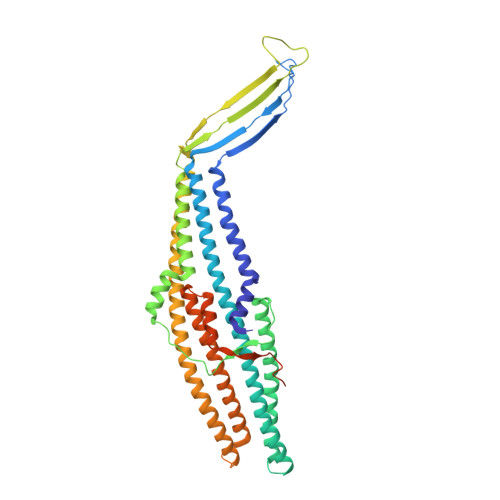Crystal structure of an antigenic outer-membrane protein from Salmonella Typhi suggests a potential antigenic loop and an efflux mechanism.
Guan, H.H., Yoshimura, M., Chuankhayan, P., Lin, C.C., Chen, N.C., Yang, M.C., Ismail, A., Fun, H.K., Chen, C.J.(2015) Sci Rep 5: 16441-16441
- PubMed: 26563565
- DOI: https://doi.org/10.1038/srep16441
- Primary Citation of Related Structures:
5BUN - PubMed Abstract:
ST50, an outer-membrane component of the multi-drug efflux system from Salmonella enterica serovar Typhi, is an obligatory diagnostic antigen for typhoid fever. ST50 is an excellent and unique diagnostic antigen with 95% specificity and 90% sensitivity and is used in the commercial diagnosis test kit (TYPHIDOT(TM)). The crystal structure of ST50 at a resolution of 2.98 Å reveals a trimer that forms an α-helical tunnel and a β-barrel transmembrane channel traversing the periplasmic space and outer membrane. Structural investigations suggest significant conformational variations in the extracellular loop regions, especially extracellular loop 2. This is the location of the most plausible antibody-binding domain that could be used to target the design of new antigenic epitopes for the development of better diagnostics or drugs for the treatment of typhoid fever. A molecule of the detergent n-octyl-β-D-glucoside is observed in the D-cage, which comprises three sets of Asp361 and Asp371 residues at the periplasmic entrance. These structural insights suggest a possible substrate transport mechanism in which the substrate first binds at the periplasmic entrance of ST50 and subsequently, via iris-like structural movements to open the periplasmic end, penetrates the periplasmic domain for efflux pumping of molecules, including poisonous metabolites or xenobiotics, for excretion outside the pathogen.
Organizational Affiliation:
Life Science Group, Scientific Research Division, National Synchrotron Radiation Research Center, Hsinchu, 30076, Taiwan.















